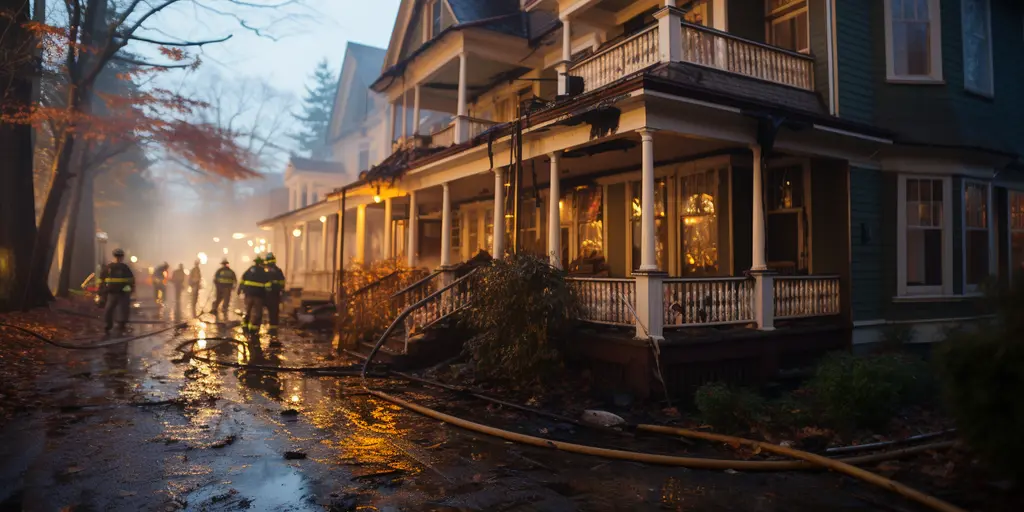Not known Facts About Dry Star Restoration
Not known Facts About Dry Star Restoration
Blog Article
The 6-Minute Rule for Dry Star Restoration
Table of ContentsUnknown Facts About Dry Star RestorationHow Dry Star Restoration can Save You Time, Stress, and Money.Getting My Dry Star Restoration To WorkIndicators on Dry Star Restoration You Should KnowIndicators on Dry Star Restoration You Need To Know
Within minutes, the cooking area was ablaze, triggering considerable damages and requiring months of remediation job. Especially in winter, home heaters are a common fire threat. Damaged circuitry or placing heaters too near combustible materials like curtains can fire up a fire. Constantly keep heaters far from anything that can burn and inspect them routinely.
Products like electric motor oil or cleaning fluids can fire up under particular problems. Constantly store these things effectively and far from heat sources. fire restoration company. Stats: According to the National Fire Protection Association, home chemicals are accountable for a noteworthy percent of home fires each year. By knowing these typical reasons, you can take steps to make your home safer.
The 5-Second Trick For Dry Star Restoration
Mold and mildew can cause wellness concerns and additional damages to your residential property. Architectural Weakening: Water can damage wood frameworks and trigger metal parts to corrosion, making your home hazardous.
Next off, we will dive into the actions involved in the fire damage remediation procedure. Fire restoration is the process of cleansing, repairing, and recovering a home that has actually been harmed by fire.
The 2-Minute Rule for Dry Star Restoration
Particles Removal and Demolition: Harmed materials are safely removed, and any dangerous materials like asbestos are dealt with appropriately. Cleaning and Purification: Residue and smoke odors are removed using specialized devices and therapies. Repair and Repair Works: Finally, the residential property is restored and recovered, consisting of architectural repair services and indoor remediation - fire damage restoration company. Fire damage includes a number of sorts of damage to a property: Physical Damage: This includes charring, smudging, and disintegration of materials directly impacted by the fire.
Water Damages: Water used to snuff out the fire can result in architectural weakening and mold and mildew growth otherwise effectively managed. Fire reconstruction professionals make use of specialized methods and devices to resolve all these sorts of damages, ensuring the building is safe and comfortable once more. Next off, we will certainly dive into the actions involved in the fire damages restoration process.
From state-of-the-art water extraction devices to specialized tools for smoke and soot removal, we have the sources needed to recover your residential or commercial property to its pre-loss problem. Our techniques are made to be complete and efficient, decreasing additional damages and quickening the recuperation procedure. Our team includes licensed service technicians who are experts in fire damages remediation.
Excitement About Dry Star Restoration
Their competence makes sure that every work is done go to this site right, supplying you with peace of mind during a difficult time. We're below to aid you restore your home and your life after the fire.
(https://www.pageorama.com/?p=dryst4rrstrtn)If there's a fire, smoke is certain to adhere to. While the fire's smoke is made up of components that make your home risky to be in, the damage smoke leaves behind doesn't stop there. Smoke will certainly float to seemingly every component of your home, sticking to furniture, style, curtains, wall surfaces, ceilings, floorings, and more.
The water will certainly soak right into the charred materials and infected other areas of the home untouched by the fire. If left untreated or missed out on throughout fire damage restoration, the water damages will just worsen with time and can result in mold development, safety and security concerns for your home's structure, and unattractive appearances around your space, consisting of warped floor covering, peeling off paint, and noticeable spots.
The Ultimate Guide To Dry Star Restoration
Water reduction is typically the very first step of the fire, smoke, and water damages repair procedure after a damage control has been completed. This resolves the water damage head-on and consists of actions to avoid more troubles for your area prior to, during, and after reconstruction. Assessment and damage control to assess the degree of water damageIsolation of water damage to affected areas to forbid water from spreading out to dry areasInspection of your home's structure for architectural stabilityExtraction of any type of standing water from the propertyStructural drying out with commercial-grade equipmentSite cleanup that will certainly remove debris, pack out salvageable material for reconstruction, and give way for restoration servicesWe'll also complete added damage reduction by boarding up damaged doors and windows, applying tarpaulins to openings in roof coverings, and finishing other actions to stop additional damages and threats to your home while the repair work are happening.
Most terms and descriptions utilized by water and fire damages repair service providers are relatively self-explanatory. The listing of terms below must be of aid when you're interacting with the company you've employed. Any kind of action taken to prevent the development and dispersing of fungi, mold and mildew, mildew, and spores. This can include using solvents or chemicals as additives or barriers on building products to stop fungus development.
Report this page